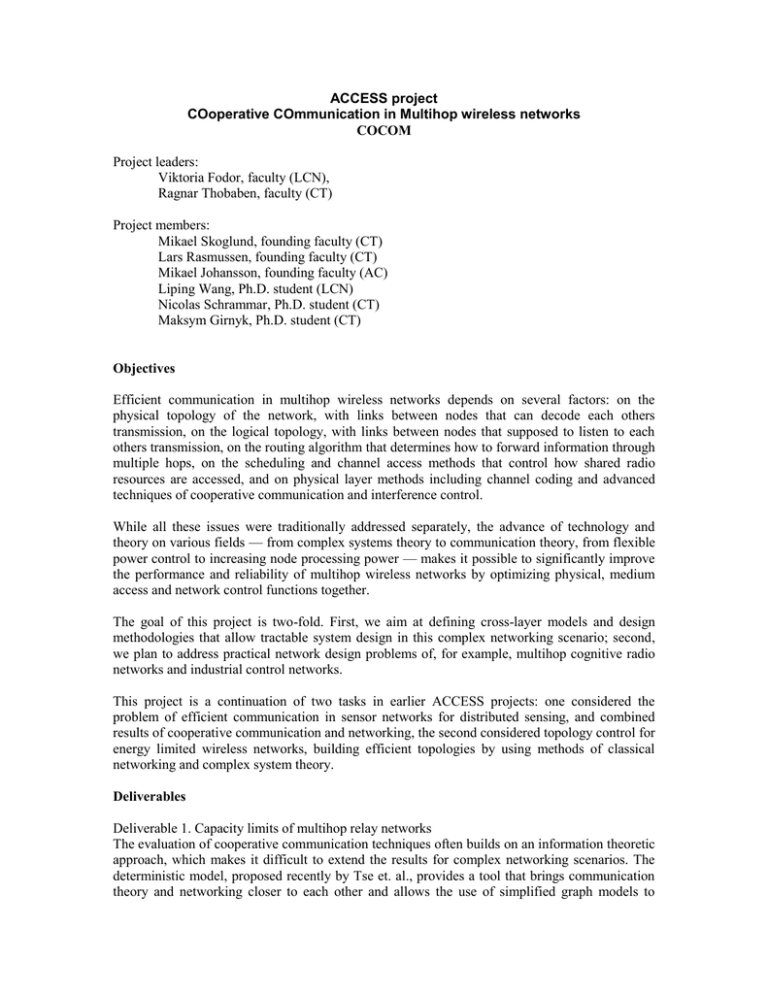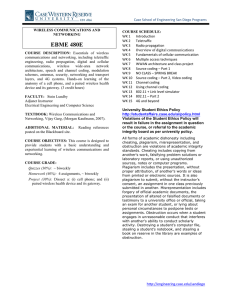ACCESS project COoperative COmmunication in Multihop wireless networks COCOM
advertisement

ACCESS project COoperative COmmunication in Multihop wireless networks COCOM Project leaders: Viktoria Fodor, faculty (LCN), Ragnar Thobaben, faculty (CT) Project members: Mikael Skoglund, founding faculty (CT) Lars Rasmussen, founding faculty (CT) Mikael Johansson, founding faculty (AC) Liping Wang, Ph.D. student (LCN) Nicolas Schrammar, Ph.D. student (CT) Maksym Girnyk, Ph.D. student (CT) Objectives Efficient communication in multihop wireless networks depends on several factors: on the physical topology of the network, with links between nodes that can decode each others transmission, on the logical topology, with links between nodes that supposed to listen to each others transmission, on the routing algorithm that determines how to forward information through multiple hops, on the scheduling and channel access methods that control how shared radio resources are accessed, and on physical layer methods including channel coding and advanced techniques of cooperative communication and interference control. While all these issues were traditionally addressed separately, the advance of technology and theory on various fields — from complex systems theory to communication theory, from flexible power control to increasing node processing power — makes it possible to significantly improve the performance and reliability of multihop wireless networks by optimizing physical, medium access and network control functions together. The goal of this project is two-fold. First, we aim at defining cross-layer models and design methodologies that allow tractable system design in this complex networking scenario; second, we plan to address practical network design problems of, for example, multihop cognitive radio networks and industrial control networks. This project is a continuation of two tasks in earlier ACCESS projects: one considered the problem of efficient communication in sensor networks for distributed sensing, and combined results of cooperative communication and networking, the second considered topology control for energy limited wireless networks, building efficient topologies by using methods of classical networking and complex system theory. Deliverables Deliverable 1. Capacity limits of multihop relay networks The evaluation of cooperative communication techniques often builds on an information theoretic approach, which makes it difficult to extend the results for complex networking scenarios. The deterministic model, proposed recently by Tse et. al., provides a tool that brings communication theory and networking closer to each other and allows the use of simplified graph models to describe the capabilities of cooperative schemes. We will evaluate the accuracy of the deterministic model in some typical scenarios and use the models to derive the capacity of multiple networks under co-optimized logical network topology design and relaying scheme. Deliverable 2. Distributed channel coding and routing for multihop relay networks The networking environment of wireless networks changes continuously due to the effect of interference from the network nodes in the same network of from networks located in the same area, due to the eventual mobility of the nodes, or changes in the radio propagation characteristics. The dynamic networking environment requires adaptive network control functions that are able to change the way network resources are utilized. In this work we will jointly consider routing and channel coding, two control functions, which are both very sensitive to the changes of the environment and affect the quality of parallel transmissions in the network, in order to achieve an improved performance with a cross-layer design. Specifically, we will consider a multihop network, where the channel conditions change dynamically, and propose a distributed routing and channel coding algorithm that builds the transmission path and selects the cooperative coding scheme hop-by-hop, according to the quality of data available at the network nodes. Deliverable 3. Resilient routing under delay constraints A specific feature of industrial communications is the combination of non-saturated and correlated traffic with (often stringent) real-time constraints on individual packet delivery. The scheduling and routing of such traffic is fundamentally different from the scheduling problems for saturated sources (i.e., where sources always have a new packet to send) that have been studied for a long time in the context of packet radio networks. Moreover, since the wireless medium is shared and since typical wireless sensor nodes often use half-duplex radios, scheduling policies for individual nodes cannot be studied in isolation but have to be coordinated across the network and ideally integrated with routing decisions. Since transmission errors are inherent in low-power wireless communication (especially in a harsh and dynamic industrial environment) an important principle for increased system reliability multi-hop mesh networking combined with resilient routing. We plan to develop techniques for computing “full diversity routes,” which explore the full time-, space-, coding- and frequency-diversity available to multi-hop wireless sensor and actuator networks. We will also explore synergies with the multihop relay networks described in Deliverable 2; essentially, relaying is a physical layer technology while resilient routing, as discussed here, sits at the network layer. Deliverable 4. Joint physical-layer and network-layer coding in multihop relay networks Decentralized network coding, suitable for wireless networks, can be based on random linear network codes where each intermediate node creates random linear combinations of incoming packets. Wireless channels exhibit inherent features resembling the encoding operation of nodes that perform random linear network coding: due to the broadcast and multiple-access features of wireless transmission, each node receives a linear combination of transmitted signals, weighting by random channel coefficients. This inherent encoding capability has potential to support elaborate joint physical-layer and network-layer coding strategies, seamlessly operating across a multi-hop wireless network. In this work we will investigate such strategies based on a crosslayer perspective. The overall aim is to develop an analytical framework for performance evaluation and for identifying constraints and technology challenges for realizing wireless random linear network coding in multihop networks.


